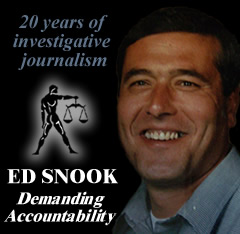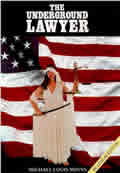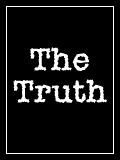LARGEST IRS REFUND IN U.S. HISTORY
By Edward Snook Investigative Journalist
November 6, 2009
NewsWithViews.com
Houston Lawyer Michael Minns beats IRS on a 30 year old case
SEATTLE,
WA - Over 30 years ago Henry Kersting put a small sign on the wall of
the Honolulu Continental Airlines Pilot bulletin board requesting investors.
It was one of the most successful low margin advertising events in American
History. In a short time the Kersting companies had 1800-plus pilots from
all over the United States, in all of the major commercial airlines, as
 investors.
Plans were made to buy banks, car rental companies, real estate, and other
commercial activity. Promises were made as to the legitimacy of numerous
estate and tax shelter planning. Ultimately, Kersting's case would become
one of the most litigated IRS tax cases in history; one where the IRS
was found to have defrauded the Tax Court. It is a case that still rages
on today with Michael Minns, the lawyer who has won more fights (counts
that the government accuses someone of criminal conduct and are found
not guilty) than perhaps any other state full of attorneys, and certainly
any other single attorney in the United States.
investors.
Plans were made to buy banks, car rental companies, real estate, and other
commercial activity. Promises were made as to the legitimacy of numerous
estate and tax shelter planning. Ultimately, Kersting's case would become
one of the most litigated IRS tax cases in history; one where the IRS
was found to have defrauded the Tax Court. It is a case that still rages
on today with Michael Minns, the lawyer who has won more fights (counts
that the government accuses someone of criminal conduct and are found
not guilty) than perhaps any other state full of attorneys, and certainly
any other single attorney in the United States.
History in brief
The IRS and Kersting did not get along. For the better part of three decades the IRS challenged and chased Kersting and his investors and in fact, when Kersting died they continued to go after his assets. Kersting had fought each and every controversy with the IRS. It was a fight that had him litigate his cases all over the United States. Kersting had numerous published decisions in various circuit courts and in Tax Court. Sadly for Kersting and his investors, every single recorded case that he fought with the IRS resulted in a victory for the IRS.
Over the decades, millions of dollars were spent with law and accounting firms all over the country for opinions, and litigation… all ending in failure for Kerstin and the investors.
The final saga in the Tax Wars with Kersting and his investors against the IRS began with a tax shelter involving numerous write-offs. These investment write-offs included, for example, interest deductions for loans and rental car deals, as well as many other items. These investment write-off deductions were used by 1800 pilots and their families. Ruthlessly deciding that they would harbor no surrender and give out no easy deals to anyone who dealt with Kersting, the IRS in many cases disallowed not only the Kersting investment deductions, but also on occasion disallowed the spousal deduction and the home interest deduction, items totally unrelated to the Kersting investments. According to the IRS, this meant Kersting and the 1800 pilots who were investors owed much more on their taxes than what had already been paid.
A few of the investors simply gave in and paid the IRS claims. A larger group paid the claims but didn’t give in; they simply paid the claims to stop penalty and interest from accruing and joined the group fighting in court. The largest group, who heeded Kersting’s advice to fight to the end and give no quarter, simply didn’t pay what was claimed and stood toe to toe waiting for a result.
The test case petitoner plan
Seeing as though Kersting and many of the investors were going to fight, the Tax court was concerned about 1800 separate cases on one tax shelter clogging up the court and the Commissioner of Internal Revenue Service didn’t want to engage in 1800 separate prosecutions. As for the 1800 tax payers (investors), they didn’t want to hire 1800 separate legal teams. So, they all entered into a contractual agreement to meet these mutual goals. Out of the 1800 tax payers the IRS would pick 5 (five) cases and the 1800 would pick five cases. These 10 cases would be representative of the whole 1800. One trial - 10 (ten) TEST CASE PETITIONERS.
Once the TEST CASE PETITONER contract was signed things began to unwind in ways, still to this day, not explained. For some reason the tax payers agreed to use only 3 cases. That meant that the 5 worst cases - the IRS obviously chose the most egregious 5 cases it could find - would be tried and defended by the legal team and instead of offsetting this with the five best cases, only three “best” cases would be added. Why did this matter? The ruling made in the case was to be a blanket ruling, affecting everyone - having only 3 against 5 meant the burden was definitely shouldered by the tax payers to win the worst cases - not a good position to begin in.
The Fraud
Unless of course the agreement to drop two of the “good petitioners” was also the result of fraud, it was after the cases were selected that the IRS committed its proven fraud on the court.
There were three honest, good case families: 1) The Hongsermiers, 2) The Thompsons, and 3) The Cravens.
IRS agents William A. Sims and Kenneth W. McWade, both attorneys, subverted the TEST CASE process by trying to tip the scale in their favor. Unknown to the Hongsermiers, and theoretically unknown to the 1800's lawyer, both the Thompsons and the Cravens made secrete deals with the IRS's Sims and McWade. The Thompson’s fired the 1800 legal team and hired an attorney named De Castro, who by coincidence wasn’t paid by the Thompsons, but was secretly paid by the IRS. The Cravens decided they didn’t need an attorney at all and they went pro-se… i.e. they represented themselves. They must have felt they had already made a deal so they didn’t need an attorney.
With the IRS manipulating the process by securing a deal, the Cravens and Thompsons effectively threw the entire case for the 1800, just to save themselves. How the trial attorney for the pilots missed all this, or the obvious fact that everyone wasn’t on the same team, is unclear. It all just flew over his head. If any of the pilots flew like this they would have often landed their planes in the wrong state.
It didn’t fly over the trial court’s head. In a blistering decision, Judge Goffe proceeded to rule against the tax payers on every issue. And, he quoted the various witnesses liberally. And in 2000, Kersting died, leaving the investors to carry on their defense.
Much later, but before the decision could be finalized, the fraud became disclosed and was revealed in a motion to Judge Goffe. What did he do? He ruled that the testimony of Cravens and Thompsons had to be stricken. Then he ruled that it didn’t matter - Listening to only Six Test Case Petitioners, where the only one chosen by the tax payers who was actually trying to win honestly was that of Captain and Mrs. Hongsermier, he wouldn’t change a comma of his opinion. With that, the case was appealed and sent up to the Ninth Circuit, which sent it back again for more review. After defeat, 500 settled, leaving 1300 Pilots who wanted to appeal.
It was at this point, one of the Pilots, Captain Gary Tjossem, succeeded in his ten year pursuit of the most winning tax attorney in the country, Michael Minns. After going over the tortured history of the case, Minns agreed to take over.
After one year Minns filed a brief with the Ninth Circuit Court, which resulted in the finding of fraud, Dixon vs. Commissioner 316 F.3d 1041. At oral argument (on tape and available by order at this paper - brief of Minns also available by this paper) Minns argued that Fraud on the Court had occurred as early as 1986. The decision, written by Judge Michael Daly Hawkins came down on January, 17, 2003 in which he rules: “The taxpayers have clearly and convincingly demonstrated Fraud on the court and are entitled to relief .” It was a landmark decision. The court sent it back down to the Tax Court with orders that all the pilots be placed in the same place as the Thompsons to wit: “on terms equivalent to those provided in the settlement agreement with Mr. Thompson.”
Goffe having retired, the case was now in Judge Beghe’s court. From 2003-2008, Beghe held hearings in California, Texas, Washington D.C., and Nevada, ostensibly trying to figure out what deal Mr. Thompson got.
One problem was that simultaneously the IRS claimed in court they gave him a 20% discount while Sims and McWade admitted in their grievance fight with Minns it was over 50%. Was the IRS still committing fraud? Two more of Minns’ successful clients died, Captain Charles Michaelson and Captain Richard Watkins.
Judge Beghe’s final ruling was that Thompson’s received 62% off their tax assessment. Penalties were thrown out, since the Thompsons didn’t pay any, and interest was stopped on those who didn’t pay from 1992 to 2008 by agreement of IRS.
Most of the pilots accepted the final victory. After all, many became millionaires, those who have paid in were entitled to as much as 30 years interest on their 62% refund; most who owed taxes owed only a fraction of the original amount, and few survivors likely would be forced into bankruptcy; but the question still remained: “Had the tax payers really gotten the same deal that the Thompsons received?”
Minns answered that question loudly: “No.” The Thompsons didn’t have the possibility of bankruptcy hanging over their head for thirty years. That’s worth something. The Thompsons didn’t have legal fees; the IRS paid their legal fees. That’s worth something. The Thompsons didn’t pay a penny of interest. That’s worth something. The Thompsons didn’t have to pay their room and board during the month long trial in Maui; but the Hongsermiers did. That’s worth something. The Thompsons didn’t sit day after day in a courtroom wondering why everything was going wrong, trying to win a case that had been essentially fixed from the start, being the only “real” case and the only “real controversy” in the court room. That’s worth something.
Judge Beghe didn’t give the Hongsermiers and the 1300 pilots they were sitting in for, a penny of credit for these things and many more.
So, in spite of the odds of getting a third audience with the ninth circuit, in spite of the odds of not getting oral argument again, Minns filed a brief and the Ninth Circuit granted the Hongsermiers’ request for oral argument and the case has been set again, for the third time, in Seattle, Washington, for oral argument before the Ninth Circuit on November 4, 2009.
Pursuing justice
Because of the January, 2003 Ninth Circuit Court of Appeals ruling that found the IRS had defrauded the tax court - effectively throwing out verdicts against 1300 tax paying airline pilots - the Chief Counsel of the IRS publically apologized to the New York Bar Association for the offense. However, the agency didn’t do anything to punish its agents, attorneys Sims and McWade for committing the Fraud. And no one has to this day apologized to the pilots.
Minns demanded that Congress look into it, and demanded action on the part of the IRS. Apparently, IRS thought the public apology was enough. None of his pilot clients lived in New York, none of them were apologized to personally, and Congress ignored the findings of the appellate court. The trial court was ordered to re-examine the case in light of the court’s rulings.
That wasn’t good enough. Minns demanded the State Bar licenses for Sims and McWade. He wanted to file and pursue an ethics grievance against them. Unheard of! According to the Journal of Taxation, no IRS lawyer had ever been found guilty of unethical conduct by their State Bar.
The government refused to release the names of the bars where Sims and McWade were licensed - They claimed it was confidential. Minns disagreed. A license is a public document. So he wrote all fifty State Bars, the District of Columbia and the Virgin Islands to find out where or if Sims and McWade had licenses to practice law. The results were interesting.
McWade was licensed in Oregon but he was practicing in Hawaii where he was not licensed. He had a license to practice before the Director of Practice, an administrative department of the IRS, and he had a license in Tax Court. He wasn’t licensed in the Ninth Circuit, which had found he had committed fraud.
Sims was licensed in Arkansas, before the Director of Practice, and before the Tax Court but that’s it.
Sims had retired from the IRS and was in private practice. McWade was still working on his pension as a government attorney.
Apparently they both thought their fraud was over, forgotten and behind them. The pilots hadn’t forgotten. The Ninth Circuit hadn’t forgotten. More importantly, Minns hadn’t forgotten and he pursued them into every jurisdiction where they were licensed. After a two year battle, in 2004, McWade received a suspension from the Oregon Supreme Court, disbarment from the Director of Practice, and suspension from the Tax Court. Likewise, Sims received a suspension from his home state of Arkansas, disbarment from the Director of Practice, and suspension from the Tax Court - the first in US history and the second in US history according to the Journal of Taxation.
The IRS was ordered to refund to the 1300 pilots 62% of the total amount originally assessed and interest was stopped as of 1992 until 2008 for the pilots who hadn’t paid. For those who had paid and were due refunds, the payments were often in the multi-million dollar area.
But it wasn’t enough. The Fraud had been discovered in 1992. But it had taken place in a court room in 1986. Minns argued to the Ninth Circuit that the IRS interest should stop when the fraud occurred, not when it was discovered, otherwise, the court was encouraging the IRS to hide Fraud. Again, remember that the Hongsermiers were to have the same agreement as the Thompsons. IRS attorneys disbarred - IRS publically rebuked for Fraud. Would that be the end of it? No.
|
Subscribe to the NewsWithViews Daily News Alerts! |
In September of 2009, the Ninth Circuit again agreed to hear Minns final complaint for the Hongsermiers and the other pilots and granted oral argument for November 4, 2009. The decision may determine whether or not the IRS is allowed to collect interest on a case that its lawyers are also committing Fraud on. Sounds simple? Here’s hoping the Ninth Circuit agrees.
A piece of advice
It is best to pay the tax if it is arguably due and fight for a refund. The IRS then, if the tax payer wins, has to pay interest (albeit at a lower rate than the tax payer has to pay) but the risk is over. The other way is to pay nothing and penalties and interest keep accruing and compounding… at a higher rate. If the taxpayer wins he pays nothing; but if the tax payer loses he pays the exorbitant increase.
[Order Minns' book "The Underground Lawyer"]
Contact Attorney Michael Minns.
� 2009 - Edward Snook - All Rights Reserved
Sign
Up For Free E-Mail Alerts
E-Mails are used strictly
for NWVs alerts, not for sale
Edward Snook is 20-plus year investigative journalist, with a college major in criminal justice and the publisher of US-Obsrver newspaper. 541-474-7885
E-Mail: ed@usobserver.com
Website: us-observer.com












